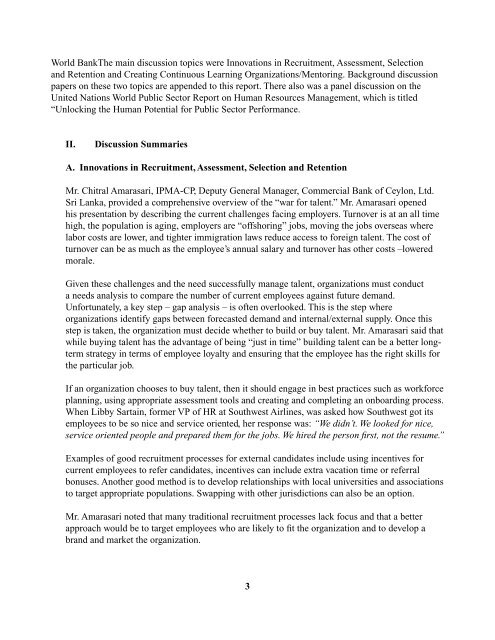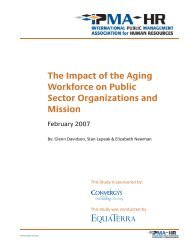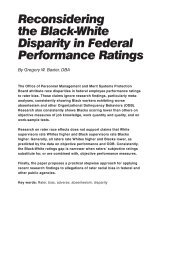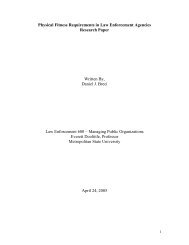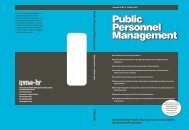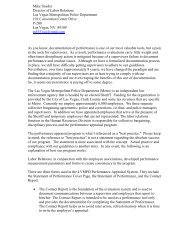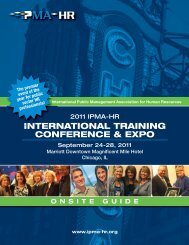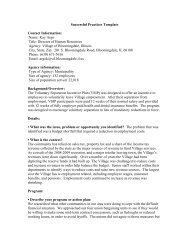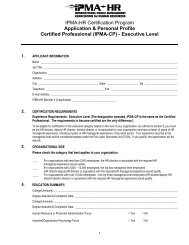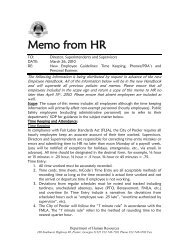31st International Symposium on Public Personnel Management
31st International Symposium on Public Personnel Management
31st International Symposium on Public Personnel Management
Create successful ePaper yourself
Turn your PDF publications into a flip-book with our unique Google optimized e-Paper software.
World BankThe main discussi<strong>on</strong> topics were Innovati<strong>on</strong>s in Recruitment, Assessment, Selecti<strong>on</strong>and Retenti<strong>on</strong> and Creating C<strong>on</strong>tinuous Learning Organizati<strong>on</strong>s/Mentoring. Background discussi<strong>on</strong>papers <strong>on</strong> these two topics are appended to this report. There also was a panel discussi<strong>on</strong> <strong>on</strong> theUnited Nati<strong>on</strong>s World <strong>Public</strong> Sector Report <strong>on</strong> Human Resources <strong>Management</strong>, which is titled“Unlocking the Human Potential for <strong>Public</strong> Sector Performance.II.Discussi<strong>on</strong> SummariesA. Innovati<strong>on</strong>s in Recruitment, Assessment, Selecti<strong>on</strong> and Retenti<strong>on</strong>Mr. Chitral Amarasari, IPMA-CP, Deputy General Manager, Commercial Bank of Ceyl<strong>on</strong>, Ltd.Sri Lanka, provided a comprehensive overview of the “war for talent.” Mr. Amarasari openedhis presentati<strong>on</strong> by describing the current challenges facing employers. Turnover is at an all timehigh, the populati<strong>on</strong> is aging, employers are “offshoring” jobs, moving the jobs overseas wherelabor costs are lower, and tighter immigrati<strong>on</strong> laws reduce access to foreign talent. The cost ofturnover can be as much as the employee’s annual salary and turnover has other costs –loweredmorale.Given these challenges and the need successfully manage talent, organizati<strong>on</strong>s must c<strong>on</strong>ducta needs analysis to compare the number of current employees against future demand.Unfortunately, a key step – gap analysis – is often overlooked. This is the step whereorganizati<strong>on</strong>s identify gaps between forecasted demand and internal/external supply. Once thisstep is taken, the organizati<strong>on</strong> must decide whether to build or buy talent. Mr. Amarasari said thatwhile buying talent has the advantage of being “just in time” building talent can be a better l<strong>on</strong>gtermstrategy in terms of employee loyalty and ensuring that the employee has the right skills forthe particular job.If an organizati<strong>on</strong> chooses to buy talent, then it should engage in best practices such as workforceplanning, using appropriate assessment tools and creating and completing an <strong>on</strong>boarding process.When Libby Sartain, former VP of HR at Southwest Airlines, was asked how Southwest got itsemployees to be so nice and service oriented, her resp<strong>on</strong>se was: “We didn’t. We looked for nice,service oriented people and prepared them for the jobs. We hired the pers<strong>on</strong> first, not the resume.”Examples of good recruitment processes for external candidates include using incentives forcurrent employees to refer candidates, incentives can include extra vacati<strong>on</strong> time or referralb<strong>on</strong>uses. Another good method is to develop relati<strong>on</strong>ships with local universities and associati<strong>on</strong>sto target appropriate populati<strong>on</strong>s. Swapping with other jurisdicti<strong>on</strong>s can also be an opti<strong>on</strong>.Mr. Amarasari noted that many traditi<strong>on</strong>al recruitment processes lack focus and that a betterapproach would be to target employees who are likely to fit the organizati<strong>on</strong> and to develop abrand and market the organizati<strong>on</strong>.3


